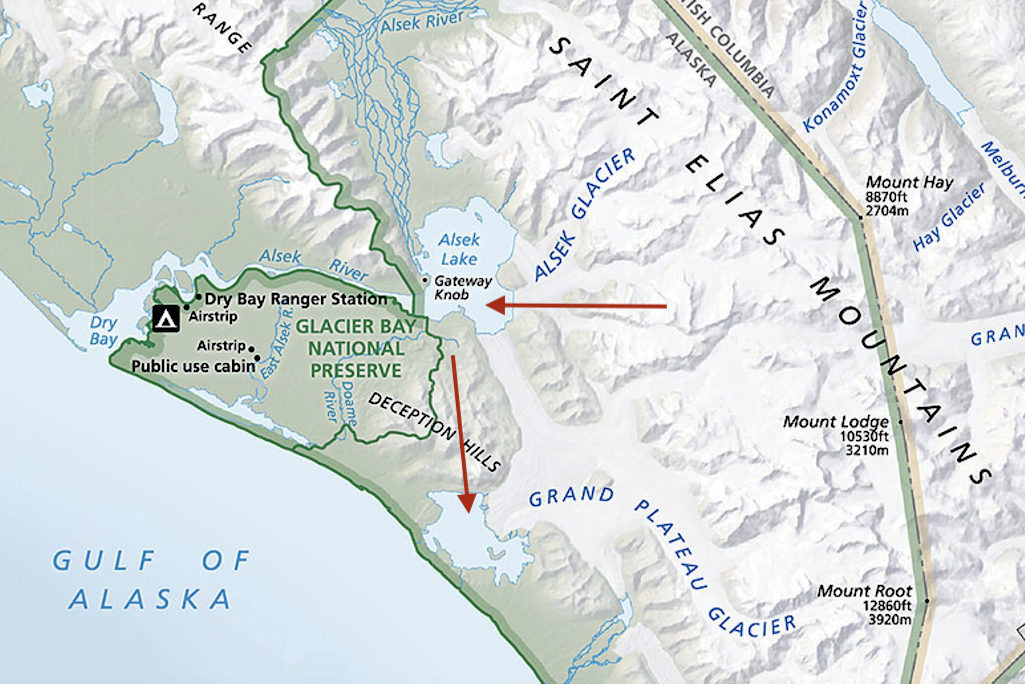
The retreat in the coming decades of the Grand Plateau Glacier should cause the Alsek River to change its path to the Gulf of Alaska at Dry Bay to a point some 17 miles to the south below Grand Plateau Lake/NPS map
A warming climate is expected to reroute an Alaskan river at Glacier Bay National Park and Preserve, shifting its outlet to the Gulf of Alaska by more than 17 miles and, in the process, upsetting the local economy tied to commercial, subsistence, and sport fishing, as well as a rafting experience that draws clients from around the world.
The driver of this shift is the ongoing retreat of the Grand Plateau Glacier, which long has served as a barrier that turned the Alsek River to the west from Alsek Lake and down into the Pacific Ocean at Dry Bay. Within a few decades, however, the melting of the glacier will likely remove the barrier between Alsek and Grand Plateau lakes and prompt the river to follow a steeper gradient down to Grand Plateau Lake, and from there into the ocean. In addition to impacting human activities, this predicted shift in the river's course will likely impact predators that long have relied on anadromous fish that head from the ocean into the Alsek River at Dry Bay.
Because the new outlet from Grand Plateau Lake lies within officially designated wilderness in the national park, the commercial entities will not be allowed to follow the river into the wilderness.
"Driven by climate-change induced glacier retreat, the lower course and mouth of the Alsek River appear poised to migrate into a protected area where most of the traditional, commercial, and legally protected activities in Dry Bay cannot legally follow," a team of scientists led by National Park Service glaciologist Michael Loso wrote in a paper that appeared in the March 17 edition of Geomorphology.
"The landscape scale and ecosystem consequences of this change are substantial, even in the context of the rapidly evolving and largely glacier covered southern coast of Alaska," they added. "Even more unusual for this sparsely populated region is the range of expected socio-economic impacts. Traditional subsistence activities, commercial fishing, guided and unguided sportfishing, recreational rafting, and associated National Park Service infrastructure in Dry Bay are all dependent, to varying degrees, on the Alsek River."
The Alsek River originates in the St. Elias Mountain Range in Canada and flows through Glacier Bay National Park and Preserve before emptying into the Pacific Ocean. The name is of Tlingit origin and may mean "place where people rest." Managed by the National Park Service, the current mouth of the Alsek River is both a premier international river rafting end point and the site of a commercial fishery at Dry Bay.
In reaching their prediction of the change in the Alsek River's path, the team noted that the Grand Plateau Glacier's terminus that is preventing the two lakes from becoming one currently is 300-400 meters thick, and that it is thinning at a rate of up to 10 meters per year. Once the terminus no longer blocks the water from Alsek Lake from heading down to Grand Plateau Lake, the Alsek River probably will change its path and follow the steeper gradient down to Grand Plateau Lake and from there to the Pacific, they noted.
“Glaciers are shrinking throughout Alaska’s national parks” said Loso, “but this situation is unusual because the glacier retreat is likely to shift the course of a major international waterway.”



Add comment